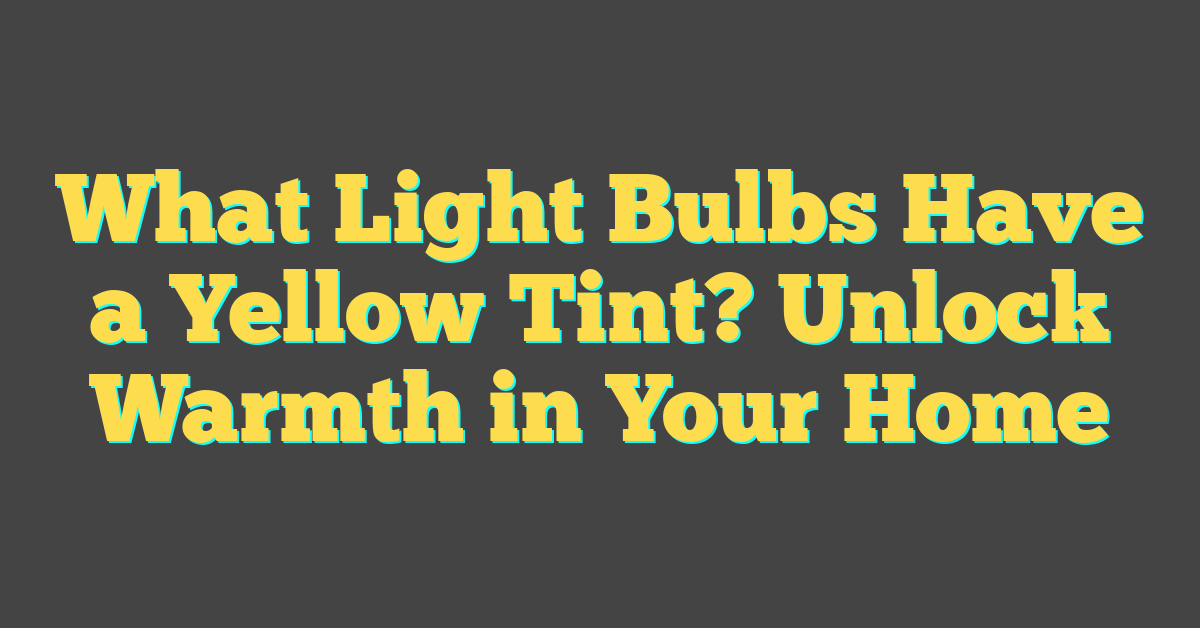Ever wandered down the lighting aisle and noticed some bulbs cast a warm, yellow glow? That’s not by chance. It’s all about the color temperature, and those with a yellow tint are often the coziest of the bunch. They’re perfect for creating a relaxing ambiance in your home.

Choosing the right bulb isn’t just about wattage or energy efficiency; it’s also about the mood you want to set. Yellow-tinted bulbs, often referred to as “soft white” or “warm white,” bring a certain charm that’s hard to replicate with their cooler counterparts.
So, if you’re looking to add a touch of warmth to your space, stick around. You’ll discover which bulbs to look for and how they can transform your room into a cozy haven.
What is color temperature?
When you’re on the hunt for the perfect bulb to cast that warm glow over your living space, understanding color temperature is your ticket to making an informed choice. Think of color temperature like a numerical way to describe the appearance of light emitted by a bulb—measured in degrees Kelvin (K). The scale ranges from warm, inviting lights to bright, cool ones, affecting the mood and aesthetic of your room dramatically.
Lower Kelvin numbers mean the light appears more yellow and is referred to as “warm” light, similar to the calm and comforting hues of a sunset. Generally, residential spaces thrive under a color temperature between 2000K to 3000K, where you get that sought-after yellow tint.
On the opposite side of the spectrum, higher Kelvin numbers produce what’s referred to as “cool” light. These bulbs emit a bluer, more energetic light, often chosen for offices or commercial spaces where alertness and concentration are key. You’ll find these color temperatures typically falling above 4600K.
To give you a clear picture of how color temperature translates to the bulbs you’ll find on shelves, here’s a quick breakdown:
| Color Temperature (Kelvin) | Lighting Appearance |
|---|---|
| 2000K – 3000K | Warm, Yellowish Light |
| 3100K – 4500K | Neutral to Cool White |
| 4600K and higher | Cool, Bluer Light |
Armed with this knowledge, you can shop with confidence, searching for warm light bulbs that add that cozy ambiance to your home. Remember, it’s not just about how bright the light is, but the quality and feel of the light—how it cozies up those nooks and crannies and fills your room with a comforting embrace. So next time you’re in the aisle looking at options, pay attention to those Kelvin numbers and choose a bulb that will transform your space into the sanctuary you’re dreaming of.
The importance of color temperature in lighting

When you’re knee-deep in your latest home DIY project, the color temperature of your light bulbs is a vital factor to consider. Picture this: you’ve just applied a new coat of paint, and it looks fantastic. But when you flip the switch, the lighting casts an unexpected glow, and suddenly, those warm beige walls might seem too yellow. That’s color temperature at play.
Color temperature influences not just the look of your room, but your perception of colors within it. It’s measured in Kelvin (K) and typically ranges from 2200K to 6500K. Lower Kelvin values mean a warmer, yellowish light, while higher Kelvin values produce a cooler, bluish light.
Here’s a quick look at the color temperature scale:
| Kelvin (K) | Light Appearance |
|---|---|
| 2200K-3000K | Warm White |
| 3100K-4500K | Cool White |
| 4600K-6500K | Daylight |
So, why does this matter to you? When you choose a light bulb with a yellow tint, you’re probably looking at bulbs with a color temperature around 2700K to 3000K. These bulbs fall into the ‘Warm White’ category and emit a cozy, calming light perfect for living rooms or bedrooms where relaxation is key.
Understanding the ambiance you want to create guides your choice of bulbs. Aiming for a productive home office? You might opt for a ‘Cool White’ light that keeps you alert. Planning an intimate dinner? ‘Warm White’ bulbs could add to the magic.
Say you’re lighting a space with artwork or photographs. Accurate color representation is crucial. Choose a bulb with a color temperature that doesn’t distort the colors. Generally, a mid-range Kelvin count of about 4000K provides a neutral backdrop.
« Why Are Light Bulbs So Confusing? Unraveling Lumens & Color Temp Mysteries
How to Stop Light Bulbs from Sticking: 5 Fail-Safe Methods Revealed »
Remember, the more you know about color temperature, the more control you’ll have over the atmosphere of your space. Illuminate those DIY projects in the best light and make sure your living space shines just the way you’ve envisioned it.
Understanding the different types of light bulbs

When you’re on the hunt for that perfect yellow tint in your lighting, you’ll find a variety of bulbs to choose from. Each type offers distinct characteristics and benefits. Incandescent bulbs, the classics, are well-known for their warm, inviting glow. They emit a yellowish light that creates a cozy atmosphere, but they’re not as energy-efficient as their modern counterparts.
Halogen bulbs are a tad more efficient than traditional incandescent bulbs and produce a bright, white light. However, when they’re on the lower end of the color temperature scale, they can give off a light that has a soft, yellow tint, similar to the sunlight at dawn or dusk.
Then you’ve got LEDs (Light Emitting Diodes). These are the new kids on the block, famed for their energy efficiency and long lifespan. Thanks to advancements in technology, you can now find LEDs that mimic the warm yellow glow of incandescent bulbs without the energy drain. Look for LEDs labeled as “warm white” or with a color temperature around 2700K to 3000K.
Here’s a quick rundown of color temperatures you might encounter:
| Type | Color Temperature | Light Appearance |
|---|---|---|
| Warm White | 2700K – 3000K | Yellowish |
| Cool White | 3100K – 4500K | Neutral to cool |
| Daylight | 4600K – 6500K | Blue-white |
CFLs (Compact Fluorescent Lamps), though less popular now due to the rise of LEDs, can still be found with a warm color temperature. Like LEDs, choose CFLs in the “warm white” category to achieve that yellowish hue you’re aiming for.
Remember that each bulb type also comes in various shapes and sizes—spirals, orbs, floods, and more—each designed to serve a specific purpose. Whether you’re illuminating your reading nook or setting the stage for your evening soiree, there’s always an ideal option available. Just keep in mind that the right bulb not only lights up a room but also enhances the mood and functionality of your space.
Light bulbs with a yellow tint

When you’re on the hunt for that warm, inviting glow for your cozy reading nook or to create a relaxed ambiance in your dining room, bulbs emitting a yellow tint are your go-to. These bulbs have a lower color temperature, measured in Kelvins (K), which translates to a warmer light appearance. Typically, you’re looking at a range between 2200K to 3000K for that desired yellowish hue.
Incandescent and Halogen Bulbs have naturally been the stalwarts for warm light. Their glow, mirroring the sunrise or sunset, is all about setting a tranquil scene. They dip into the lower end of the Kelvin scale, making them a default choice when you need that golden hour effect all evening long.
LED bulbs, though known for their versatility, also offer options in warmer tones. In fact, they’re quite a sustainable choice due to their energy efficiency. LED bulbs come in various white light spectrums, including “warm white,” which casts a yellowish light resembling the traditional incandescent bulbs.
For a similar glow with energy-saving perks, Compact Fluorescent Lamps (CFLs) are a solid pick. While they used to lag behind in achieving the warmer end of the color spectrum effectively, modern CFLs have come a long way. Look for CFLs labeled “warm white” or “soft white” to meet your yellow tint requirements.
Dimmable bulbs across these types can further enhance the experience. By adjusting the brightness, you’re able to fine-tune the intensity of the light and, as a result, the tint. It’s a DIY tip that works wonders—installing a dimmer switch isn’t just practical, it adds another layer of customization to your lighting setup.
In spaces where ambience is everything, the glow of your light bulbs plays a starring role. Whether it’s a lamp on your end table or a fixture over your bar, choosing the right bulb with a yellow tint can turn an ordinary room into your personal retreat or an inviting space for guests.
Creating a cozy ambiance with yellow-tinted bulbs

When you’re aiming for a snug and welcoming environment, the choice of light bulbs is crucial. Yellow-tinted bulbs are your best bet for crafting that perfect cozy ambiance. Whether you’re curling up with a good book or hosting a dinner party, the right lighting sets the mood.
These bulbs are not just about their hue; they’re a blend of aesthetic appeal and functional warmth. A yellow tint in a bulb can soften stark spaces and introduce a sense of calm to your room. The gentle illumination mimics the golden hour of a sunset, filling your space with a serene glow.
Ideal Spaces for Yellow-Tinted Lighting
- Bedrooms
- Living areas
- Dining rooms
In the bedroom, a yellow-tinted bulb can make winding down at the end of the day easier on your eyes and mind. The warmth promotes relaxation, signalling to your brain that it’s time to rest.
Living areas benefit immensely from yellow-tinted lighting. Subtle illumination draws attention to design features, such as wall art or furniture, adding depth and character.
In dining rooms, where conversations take hold, the soft light from yellow-tinted bulbs can be the unspoken guest that makes everyone feel at home. They flatter food and company alike, creating an inviting scene for memorable meals.
For a DIY lighting project, consider pairing yellow-tinted bulbs with unique fixtures. Lanterns or globes with a hint of opacity can enhance the yellow glow and distribute it evenly. If you’re into smart home tech, explore smart bulbs that offer a range of yellow shades, adjustable via an app. You’re not just installing a light source—you’re crafting an experience.
Remember, beyond the visual appeal, it’s about how the light makes you feel. As a lighting aficionado, you know it’s in the subtleties that a house becomes a home. Embrace the yellow glow, and you’ll find the warmth extends beyond the bulb.
Conclusion
You’ve seen how yellow-tinted bulbs can transform your space into a sanctuary of warmth and tranquility. Whether you’re curling up with a book in your bedroom or hosting a dinner party in your dining room, the right lighting sets the perfect mood. Don’t forget to play around with different fixtures and smart bulb features to find the shade of yellow that feels just right for you. After all, it’s not just about how your space looks—it’s about how it makes you feel. So go ahead, switch on that yellow glow and let the cozy vibes flow.
Frequently Asked Questions
What is the advantage of yellow-tinted bulbs in home lighting?
Yellow-tinted bulbs produce a warm hue that creates a cozy ambiance, softens spaces, and induces a calming effect. They are particularly beneficial in bedrooms, living areas, and dining rooms to encourage relaxation and enhance the atmosphere.
Can yellow-tinted bulbs add depth to design features?
Yes, the warm light from yellow-tinted bulbs can add depth to design elements, highlighting textures and features within a space, and contributing to the overall aesthetic of interior design.
Where should you use yellow-tinted bulbs in your home?
Yellow-tinted bulbs are ideal for use in bedrooms, living areas, and dining rooms, where a warm and inviting atmosphere is desired to promote relaxation and comfort.
Are there smart bulbs available that provide yellow shades?
Smart bulbs that offer adjustable yellow shades are available, allowing users to customize the warmth and intensity of the light according to their preferences and the needs of different spaces.
Why is the feeling evoked by the light important?
The emotional impact of lighting is significant since it influences the ambiance of a room and how comfortable and welcome people feel within that space. Embracing the yellow glow of bulbs can extend warmth beyond the physical light and impact the mood and feel of a home.




